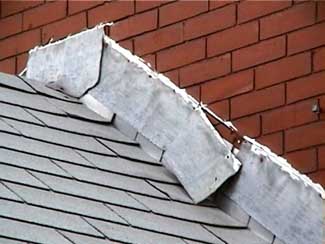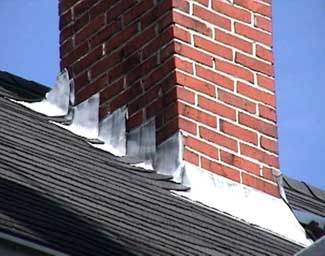From the Roof Down...and Skin Deep

What & When to Repair
The Roof/Gutter System
Wall/Chimney Flashing
|
|

Flashing before repair. Photo: ŠJohn Leeke.
|
Not Recommended
Losing Connections. Here, the step-flashing (beneath) is
interwoven well with the shingles, but the counter flashing (above) has
failed. A modern "riglet", or groove, has been sawn into the face of the
bricks. Then the strip of counter-flashing was nailed into the mortar joints
and the top edge sealed with "white goop." These inappropriate methods lasted only
a few years.

Flashing after repair. Photo: ŠJohn Leeke.
|
Recommended
Re-Connecting. This step-flashing keeps water from
penetrating the joint between the roof and the chimney. Each piece of
flashing is tightly sealed at the top with mortar in the brick masonry, lays
flat against the chimney and the next flashing, and is inter-woven with the
shingles on the roof. Every part overlaps the next in a downward slope to
shed water draining down the face of the chimney and the roof.
Plan your work: Check yearly for gaps, cracks or missing flashing. Use these traditional methods and materials because we know, from long-term experience, that they are the most effective.
Maintenance tip: Do not depend upon caulks, sealants or "goop" to do what metal
flashing can do better.
|
|


